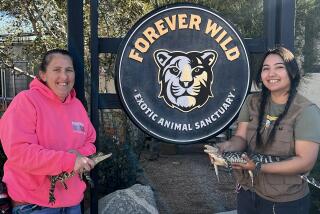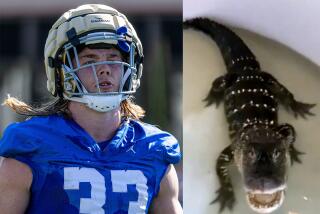Alligator ‘Relocaters’ Wrestle With Growing Problem : Environment: In Louisiana, man and the reptiles are increasingly getting in each other’s way. Special hunters move or kill the nuisance animals.
- Share via
BATON ROUGE, La. — Like the alligator, Joe Arledge in repose--say over coffee down at the Waffle House--seems no more deadly than an old log lying by the road.
He is an amiable fellow, a slightly built man with black hair and bushy eyebrows who loves to talk, especially about alligators.
Listen:
“Now the alligator is not a man-eater,” he said between sips of coffee. “It’s not gonna go out there and eat you. But every once in a while, you’ll get one that will. They’ve got some mean ol’ gators.
“And you especially don’t want to stand in their way if they’re moving toward the water. Man, even the little bitty ones will bite you. They learn early what their mouths are for.”
He’s just a country-talking raconteur, a good-natured bard of the bayou, spinning his tales in his blue work shirt with the tail out, calling the young waitress by her first name and charming her, quite innocently, the way he charms everyone.
The image he presents, though, is deceiving. He doesn’t look it, but this 44-year-old chemical plant worker with a face covered in stubble and hair graying at the temples, is a Davy Crockett of the quagmire. And he can whump any alligator that comes his way.
“I just like it,” he said, grinning like a reptile in the sun, an alligator tooth on a chain around his neck. “I looove to mess with the alligator. . . . Man likes to go kill the grizzly bear because, I guess, that’s the meanest thing there is. Well, down here it’s the alligator. That’s the meanest thing we got.”
This year, Arledge has had plenty of gators to mess with.
Heavier than usual rainfall has sent a record number of alligators scurrying for higher ground. Often, they wind up in someone’s back yard or patio or on a public road.
In a state with upward of 750,000 wild alligators, many of them living in fairly close proximity to humans--for example, in the lake adjacent to the governor’s mansion and state Capitol in Baton Rouge--that can cause quite a problem.
Not that the alligator is a particularly dangerous animal if it is left alone. The problem is people don’t leave them alone. Folks have a bad habit of feeding them.
“The alligator normally is a very shy-type individual,” said James Manning, an official of the state Department of Wildlife and Fisheries. “But if they learn in that small brain they have that when they see a human being, that means food, then they’re dangerous.”
They will begin to come out of hiding when they see humans approach. “And if your dog is right there, he’ll eat your dog, or your cat, or he’ll bite your leg,” he said. “He don’t care. He’s used to a free meal when he sees people.”
The last documented fatality in Louisiana attributed to an alligator was in the early 1700s. And most of the injuries caused to humans by the beasts since then have been minor, Manning says. But there have been a few doozies.
“The last (serious injury) I can remember was a couple of years ago when a guy and his girlfriend were out fishing in one of the lakes southwest of here,” Manning said from his office in Baton Rouge.
“Here was an alligator, and he’s goin’ to show his girlfriend that he’s macho and goin’ to wrestle an alligator,” he said. “He jumps on top of it, and it almost eats him up.”
So alligator hunters like Arledge serve a valuable public service. He is one of about 70 unpaid “nuisance alligator relocaters” operating in Louisiana under an agreement with the wildlife and fisheries department. They attempt to catch and relocate alligators away from humans, but if the reptile is too big or is impossible to capture alive, they can kill it and keep the skin and meat.
“I like it,” Arledge said. “It tastes like pork to me.”
The relocaters say they don’t like to harvest small gators (less than six feet is the limit for Arledge) and will only kill them if it is impossible to catch them alive.
Hunters kill between 350 and 500 alligators in the state during a normal year. “This year, it will probably go to 750 to 800” because of the heavy rainfall, Manning said. Arledge has caught about 30 and “harvested” eight so far this year, a lot more than the 28 total calls he got in 1990.
But other hunters who devote more time to it have caught many more. Kenny Schmill, an alligator hunter who lives near New Orleans, says he’s caught 152 so far this year, compared to 67 all of last year. He says he was averaging six calls a day earlier in the summer.
Natural migration is one of the reasons so many Louisianians find alligators in their back yards, but the problem is aggravated by people who take baby alligators as pets, says C. J. Boudreaux, another relocater who lives near Baton Rouge.
Arledge thinks that’s how a lake near Louisiana State University in Baton Rouge got infested with the animals.
“People are curious,” Boudreaux said. “They’ll go out into the swamp area and catch them a lizard not much more than eight inches long. They’ll take it home and feed it insects and mosquitoes, and before they know it, it’ll be a foot-and-a-half long after a year and a half, and they won’t want to fool with it anymore. So they’ll go throw it in a neighbor’s pond. Then a few years from now, the neighbor’s got a six- or seven-foot alligator in the pond.”
But enough dawdling. The night is wasting away. Let’s go hunt some alligator.
The rains have eased up lately and so have the calls. But Arledge has this one gator he’s been trying to catch down in St. Amant, La., south of Baton Rouge.
It’s only three or four feet long, but property owner Van Lambert wants it out of his pond.
A neighbor who likes to catch bullfrogs in the pond discovered the alligator about three months ago. He had come over with a weed-eater to chop down the high grass to go frogging when he caught a glimpse of it.
“We decided to do something with it because of the kids in the neighborhood who play around here,” said Lambert, who came out with his family to watch Arledge in action. “We’ve got a 4-year-old, and with all the kids in the neighborhood, you can’t take a chance with it. They’d be out here playing with it before you know it.”
It’s pitch-black out. Beneath the towering cypress and pines that crowd the pond, Arledge and his 17-year-old son, Chad, prepare to set out in their 12-foot boat across the inky water choked with lily pads and weeds. The night is filled with the coughing barks of bullfrogs and the shrill chirping of crickets.
Out in the water, the elder Arledge stands up in the boat, which sways with his every move. He’s wearing a cap with a light attached to it, similar to a miner’s helmet. He shines it at the water while his son paddles.
He plans to scan the pond until he sees the alligator’s eyes shining in the glare of the spotlight. A full-grown alligator’s eyes glow red, a younger one’s eyes glow bright yellow. With the light blinding the creature, the younger Arledge will paddle up to the alligator and carefully slip a noose over its head.
If the noose touches the alligator in the slightest, it will dive underwater. That’s what happened on the Arledges’ previous trip. They chased the gator all over the pond, even falling into the water one time, but they never were able to catch it.
With a small alligator like this, Arledge would have simply pulled the animal into the boat and thrown it into a sack if they had caught it. A slightly larger gator--up to six feet--would have its mouth taped shut and its feet tied. But if it’s over six feet long, Arledge won’t even attempt to put it into his boat. “With its tail, a big gator could smash this boat to pieces,” he said, almost whispering.
On land, the way to catch a gator that is seven feet long or more is by wrestling it into submission, Arledge says. The trick is to blind it. You throw a sack over its head so it can’t see. It’ll flip and thrash about wildly--it can break a man’s leg with one whack of its tail--but you’ve got to let it expend its energy. Then you straddle it.
“When its mouth is closed, you push down on its snout and then, while holding its mouth closed, you pull up hard while sitting on its back,” he said. After taping its mouth shut, Arledge says he ties its legs behind its back, “like a policeman making an arrest.”
But with a big alligator in a pond, Arledge has to set a trap, which usually means the alligator has to be killed, because the swallowed hook will tear its insides to pieces.
Arledge says that, whenever possible, he doesn’t kill an alligator without giving the property owner a choice. “Some people are kinda funny about killing animals, you know,” he said. “They don’t like to see them killed.”
Joe Arledge’s sight is so good that he can spot a dew drop at 20 yards, but he never catches a glimpse of the alligator this night.
“I don’t see him nowhere,” he said to the family, back on shore. “We can’t find him. The gator could’ve left or he could have hid.”
It’s possible that heavy rains earlier in the day cooled down the pond so much that the cold-blooded reptile is hidden away, waiting for warmer weather in order to come out to feed. But there is another scenario Arledge chooses to believe.
“I run him real hard the other night and . . . the way I figure it, he said: ‘Them people messing with me. I’m gonna leave.’ ”
If so, Arledge’s job is as good as done.
It’s getting late, and Chad Arledge has an exam the next morning, but his father can’t resist visiting with the Lamberts for a while. He pulls out his scrapbook of alligator photos.
Lambert looks them over admiringly.
“It’s good to see somebody who appreciates the intelligence or the savvy, or whatever you want to call it, of the gator,” he said.
More to Read
Sign up for Essential California
The most important California stories and recommendations in your inbox every morning.
You may occasionally receive promotional content from the Los Angeles Times.













